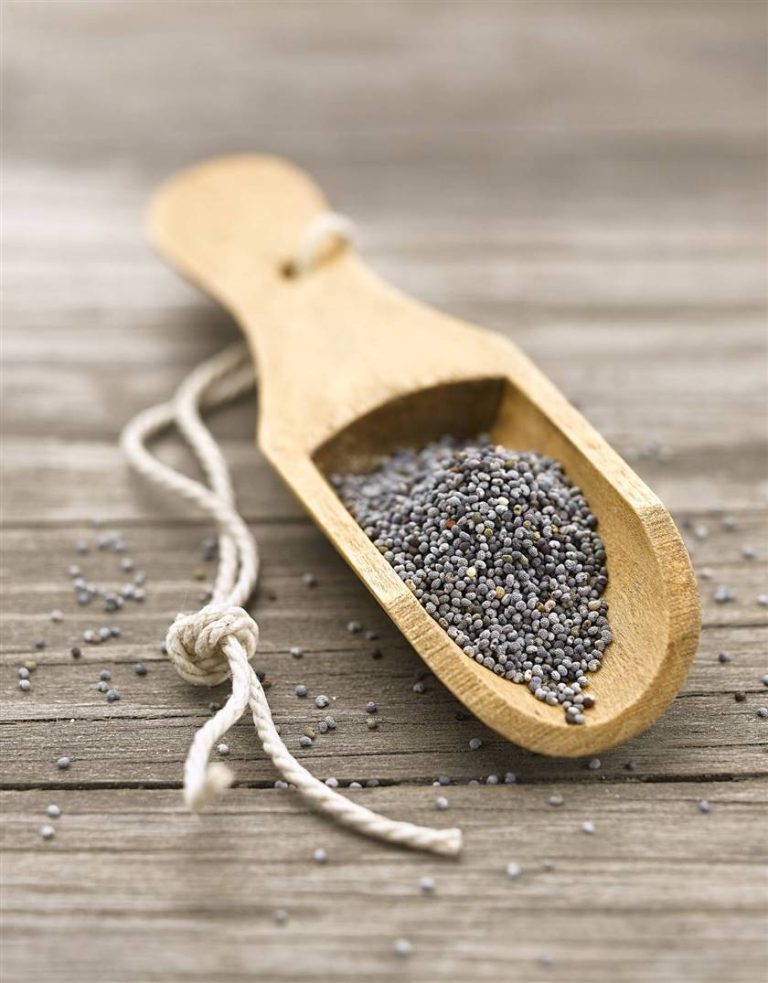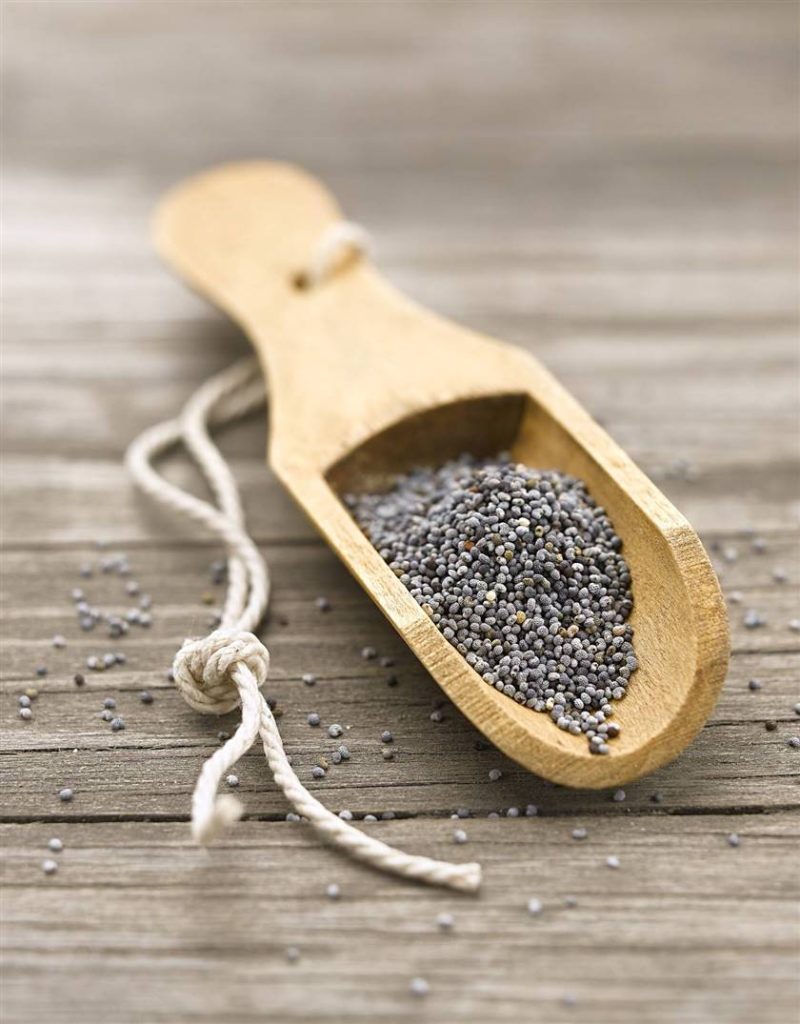
Oilseeds provide proteins and healthy fatty acids, as well as being remineralizing. Add them to your dishes to gain flavor and health.

POPPY SEEDS
Mild relaxing effect and very rich in calcium (30 g provide half of the recommended daily amount; they are the food that contains them most after algae) and other minerals: mangeneso, phosphorus, magnesium, iron and zinc.
Slightly bitter and spicy taste.
They are used as a seasoning with other seeds and algae. Also, in pastries and mixed with fresh cheese. They are very tasty in cheesecakes with lemon and rustic breads.
It is not necessary to toast them, although in doing so they give off an optimal almond aroma for salads and sauces.
They can be stored in the fridge or freezer.
PUMPKIN SEEDS
Very rich in omega-6 fatty acids. They provide zinc, magnesium, phosphorus and iron, as well as vitamin E.
They are beneficial for the male reproductive system by preventing prostate problems, are very effective in expelling intestinal worms and have a sedative effect, capable of alleviating chronic pain.
They taste like nuts and their greenish color dresses salads, creams and dishes of rice, couscous, quinoa, millet and pasta.
As a condiment it is usual to use them together with other ground seeds. Its use in bakery and pastry is noteworthy.
They can be roasted or fried and should be salted in moderation.
The oil obtained with them is very healthy because of the profile of its fats.
FENUGREEK
Also called fenugreek, fenugreek belongs to legumes, so they contain more protein than other seeds. They provide B vitamins, iron and phosphorus.
They are rich in mucilage, and therefore are laxatives and a good digestive and liver tonic: they reduce inflammation of the digestive mucous membranes.
In addition, they regulate the pancreatic secretion of insulin: thanks to its fiber, glucose absorption is reduced.
The ground seeds, of curious pyramidal shape, are used in bakery and to flavor pasta dishes, vegetables, soups… Dried they can be cooked as if they were semolina with a previous soak.
When roasted, their bitter taste is attenuated, they gain nuances of syrup or caramel and become more aromatic. As a condiment they are usually used together with other seeds and spices.
They can be germinated and added to salads.
SUNFLOWER SEEDS
Today children change pipes for garishly colored trinkets, and it is a pity, because sunflower seeds contain more protein (27%) than any other nut.
They provide a lot of vitamin E (21.8 mg/100 g) and other antioxidants. Their richness in vitamin B1 (1.9 mg / 100 g) makes them suitable for keeping the nervous system and skin in shape.
A serving of 30 g (175 calarlas) provides 40% of the magnesium needed for a day, as well as 23% of phosphorus and 15% of iron. In its fats (49%) omega-6 predominate.
The high ratio of omega-6 to omega-3 makes them less heart-healthy than other seeds, but they provide abundant vitamins (E, K and B1) and minerals (phosphorus, magnesium, selenium and iron).
They are delicious in salads, rice, sautéed vegetables, bakery and pastry. Raw and unroasted they maintain all their properties: they can be crushed into sauces, fillings or breads.
They can also be toasted, salted, fried, covered with chocolate or garapatas. Toast and washed down with soy sauce are a good appetizer.
FENNEL SEEDS
Ground fennel seeds spice up stews, vegetable dishes and salads.
They are used in confectionery and to accompany baked, sweet and savory dishes.
They promote digestion and improve infant colic and bad breath.
FLAXSEEDS
Made up of fats, proteins and fiber almost equally, they are the best vegetable source of omega-3.
A serving of 30 g covers 42% of the daily needs of folic acid, 32% of magnesium and more than 100% of vitamin E.
They help regulate cholesterol, improve intestinal transit thanks to their gelatinous consistency, which acts as a lubricant, and have antioxidant, anticancer and estrogenic properties.
They are used as a condiment previously roasted and ground, and mixed with pumpkin and sunflower seeds treated in the same way.
They are sprinkled on cereals, vegetables, soups, potatoes, mixed with yogurt or fresh cheese … They are also used in bakery and pastry without crushing, but to make better use of them it is advisable to crush them.
To take advantage of its laxative benefits, they are usually left to soak overnight along with 2 prunes and this mixture is taken on an empty stomach crushed with fruit juice.
MUSTARD SEEDS
They are often used to make the popular sauce of the same name. They are rich in selenium and are considered anti-cancer and anti-inflammatory.
Once dry it is not very spicy but when soaked and crushed, it recovers its flavor.
It can be roasted and ground to flavor root vegetables, cabbages, potatoes, cheeses… It is added at the end of cooking.
SESAME SEEDS
They are a great source of vitamins and minerals (especially calcium and magnesium). Due to their remarkable iron content (10 mg/100g) and proteins (20%) they are an energetic and remineralizing food.
Its nutty flavor with traces of coffee is accentuated when roasted.
Sprinkled on salads, pasta and soups, used in sauces, pastries and bakery, on toast, with cheese, spinach, legumes, sandwiches, pâté… They are tasty and very soft.
They are better used lightly toasted and ground, so they are usually ground or taken in the form of butter (tahini), which is spread on bread. Mixing them ground and toasted with a little salt yields a condiment called gomasio.
BUCKWHEAT
Although not a cereal, buckwheat is cooked similarly to these.
It is part of the Russian national dish (kasha). With its flour the best crepes and blinis or pancakes are made, as well as Japanese soba noodles, cookies, cakes, semolina …
In Girona its cultivation (fajol) is being recovered, after having been a common element in the landscape and in the canvases of the nineteenth century.
It is rich in protein (13.2%), magnesium, phosphorus and vitamin B3. Its flavor is intense and celiacs can take it because they lack gluten. It is an ideal food for children and convalescents. It contains choline, anti-inflammatory substance and protector of blood circulation.